Concepts de base¶
If this is your first foray into digital painting, this page should give you a brief introduction to the basic but important concepts required for getting started with digital painting in Krita.
Although very lengthy, this page tries to give a brief overview of some of the Krita's most important functionality; it tries to help you grasp the functions of various menu and buttons in Krita without going into minute details.
Trame et vecteur¶
Even though Krita is regarded primarily a raster based application, it has some vector editing capabilities as well. If you are new to digital painting medium, it is necessary that you first get yourself acquainted with the concepts of raster and Vector based images.
En imagerie numérique, un pixel (« Picture Element ») est un élément de base le plus bas d'une image. Il s'agit essentiellement d'une grille de points affichant chacun une couleur spécifique. L'édition matricielle consiste à manipuler et à modifier ces pixels. Par exemple, lorsque vous prenez un pinceau d'un pixel de couleur noire et que vous peignez sur une toile blanche dans Krita, vous changez en fait la couleur du pixel situé sous votre pinceau du blanc au noir. Lorsque vous zoomez en avant et que vous voyez un coup de pinceau, vous pouvez remarquer de nombreux petits carrés de couleur, ce sont des pixels :
Contrairement aux images matricielles, les images graphiques vectorielles sont conçues à partir d'expressions mathématiques. Elles sont indépendantes des pixels. Par exemple, lorsque vous dessinez un rectangle sur une couche :ref : « vectorielle <vector_layers> » dans Krita, vous dessinez en fait des tracés passant par des points appelés nœuds, situés à des coordonnées spécifiques sur les axes « x » et « y ». Lorsque vous redimensionnez ou déplacez ces points, l'ordinateur calcule et redessine le tracé et vous affiche la nouvelle forme. Vous pouvez donc redimensionner la forme vectorielle à volonté sans perte de qualité. Dans Krita, tout ce qui ne se trouve pas sur une couche vectorielle est considéré comme matriciel.
Images, vues et fenêtres¶
Dans un logiciel de dessin, il y a trois conteneurs majeurs formant votre espace de travail.
Image¶
La plus importante est l'Image.
This is an individual copy of the image that you can open or create via the file dialog. Krita allows you to open the file as a new copy via the File menu, or to save it as a new file, or make an incremental copy.
An image contains data regarding layers, color space of image and layers, canvas size and metadata such as creator, date created and DPI et cetera. Krita can open multiple images at once, you can switch between them via the Window menu.
Because the image is a working copy of the image on the hard drive, you can do a lot of little saving tricks with it:
- Nouveau
Réalise une nouvelle image. Quand vous appuyez sur , vous créez un nouveau fichier sur le disque dur.
- Ouvrir...
Makes an internal copy of an existing image. When you press , you will overwrite the original existing image with your working copy.
- Ouvrir un document existant comme document sans titre...
Similar to , however, will request you to specify a saving location: you're making a new copy. This is similar to in other programs.
- Créer une copie à partir de l'image actuelle
Similar to but with the currently selected image.
- Enregistrer en version incrémentale
Allows you to quickly make a snapshot of the current image by making a new file with a version number added to it.
These options are great for people doing production work, who need to switch between files quickly or have backup files in case they do something extreme. Krita also has a file backup system in the form of auto-saves, backup files and crash recovery. You can configure the option for these features in the general settings.
Vous affichez l'image grâce à une Vue.
Affichage¶
A view is a window onto your image. Krita allows you to have multiple views, and you can manipulate the view to zoom, rotate and mirror and modify the color of the way you see an image without editing the image itself. This is very useful for artists, as changing the way they view the image is a common way to diagnose some common mistakes, like a drawing which is skewed towards one side. Mirroring with the M key makes such skewing easy to identify.
If you have trouble drawing certain curves you will enjoy using rotation for drawing, and of course, there is zooming in and out for precision and rough work.
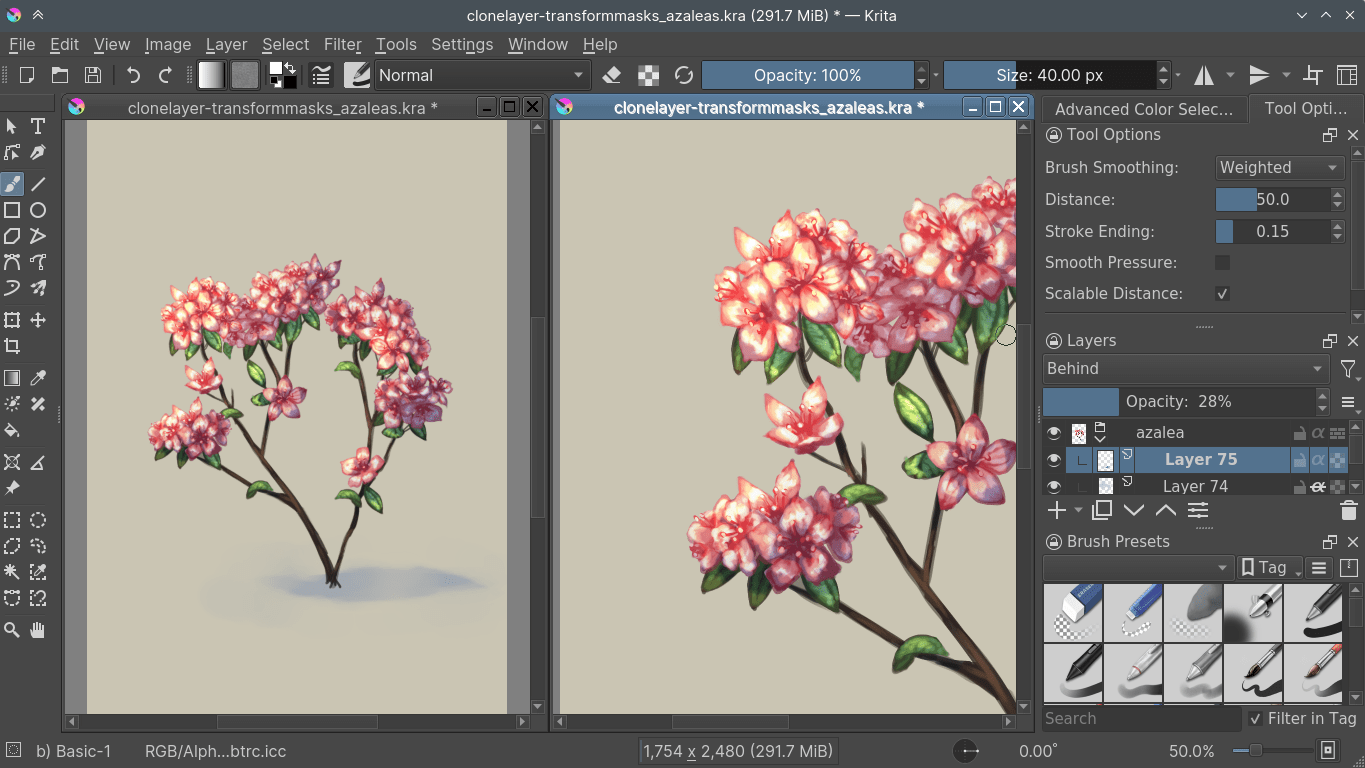
Vues multiples de la même image dans Krita.¶
Multiple views are possible in Krita via . You can switch between them via the Window menu, or the Ctrl + Tab shortcut, or keep them in the same area when subwindow mode is active in the settings, via .
Panneaux¶
Dockers are little subwindows in Krita's interface. They contain useful tools, like the color selector, layer stack, tool options, et cetera.

The image above shows some dockers in Krita.
Toutes les vues et tous les panneaux sont contenus dans Fenêtres.
Fenêtre¶
If you've used a computer before, you know what windows are: They are big containers for your computer programs.
Krita allows you to have multiple windows via . You can then drag this to another monitor for multi-monitor use.
L'image ci-dessous affiche un exemple de fenêtres multiples dans Krita.

Tableaux dans Krita¶
When you create a new document in Krita for the first time you will see a rectangular white area. This is called a canvas. You can see it in the image below. The area marked by a red rectangle is a canvas.
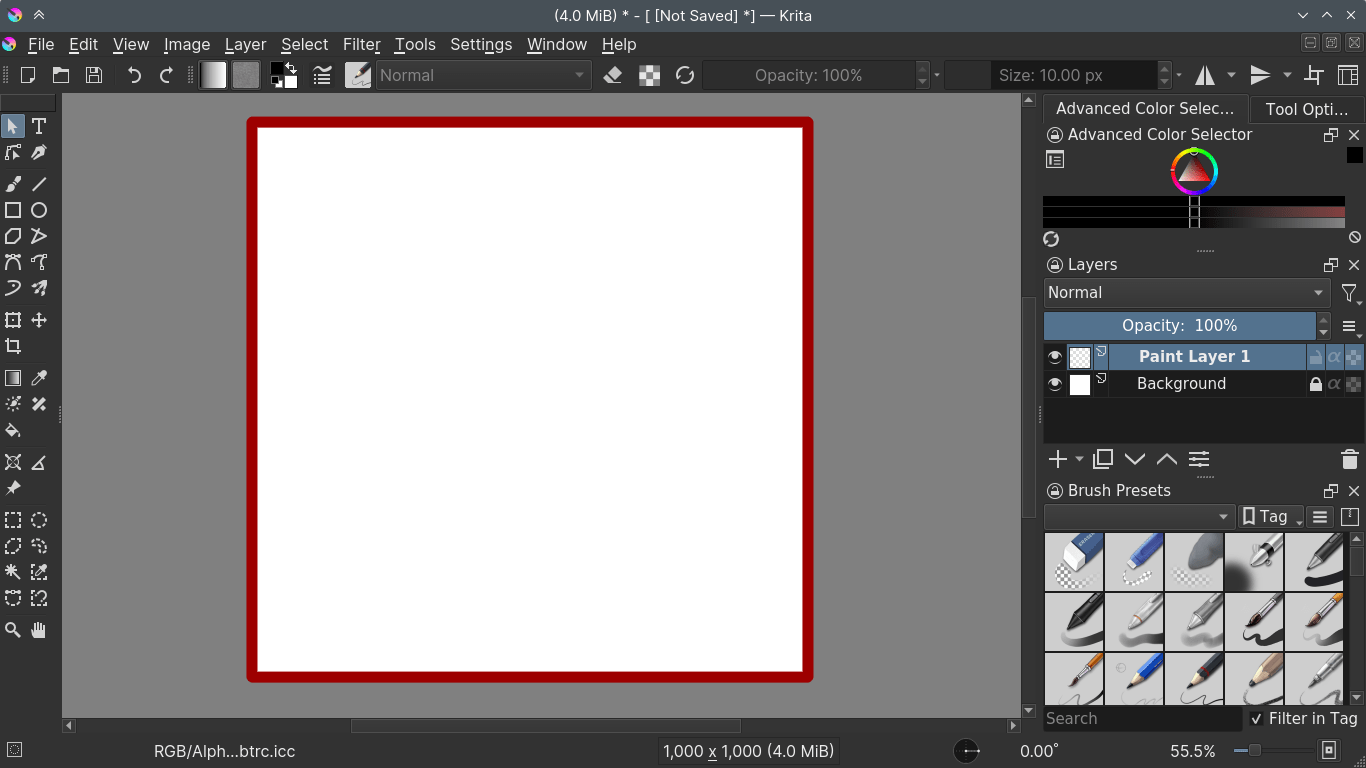
When you save the painting as JPG, PNG et cetera or take a print out of the painting, only the content inside this area is taken into consideration. Anything beyond it is ignored. Krita does store information beyond this area, you just won't be able to see it. This data is stored in the Layers.
Calques et composition¶
Comme un peintre paysagiste commencera par peindre le ciel, puis les éléments les plus éloignés avant de se diriger lentement vers les éléments du premier plan, les ordinateurs font de même avec toutes les choses que vous leur demandez de dessiner. Ainsi, si vous leur demandez de dessiner un cercle après un carré au même endroit, le cercle sera toujours dessiné plus tard. C'est ce qu'on appelle « l'ordre de dessin ».
The layer stack is a way for you to separate elements of a drawing and manipulate the drawing order by showing you which layers are drawn when and allowing you to change the order they are drawn in and also apply all sorts of other effects. This is called Compositing.
This allows you to have line art above the colors, or trees before the mountains, and edit each without affecting the other.
Krita possède de nombreux types de calques. Chaque type de calque est unique et possède son propre cas d'utilisation :
- Calques de dessin
Ceux-ci sont des calques de trames et le type de calque par défaut des plus communs dans Krita, sur lesquels vous dessinerez.
- Vector Layers
This is a layer type on which you draw vector graphics. Vector graphics are typically more simple than raster graphics and with the benefit that you can deform them with less blurriness.
- Calques de groupe
These allow you to group several layers via drag and drop, so you can organize, move, apply masks and perform other actions on them together.
- Clone Layers
These are copies of the layer you selected when making them. They get updated automatically when changing the original.
- Calques de fichier
These refer to an existing image outside Krita and update as soon as the outside image updates. Useful for logos and emblems that change a lot.
- Calques de remplissage
Ces calques sont remplis avec quelque chose que Krita peut faire à la volée, comme des couleurs ou des formes.
- Calque de filtrage
These layers help us to apply some filters which will affect a composite image made from all the layers beneath them.
Vous pouvez manipuler le contenu des calques avec Outils.
Outils¶
Tools help you manipulate the image data. The most common one is of course, the freehand brush, which is the default when you open Krita. There are roughly five types of tools in Krita:
- Outils de dessin
These are tools for painting on paint layers. They describe shapes, like rectangles, circles and straight lines, but also freehand paths. These shapes then get used by the Brush engines to make shapes and drawing effects.
- Outils de vecteurs
This is the upper row of tools, which are used to edit vectors. Interestingly enough, all paint tools except the freehand brush allow you to draw shapes on the vector layers. The resulting object won't use the brush preset for outline unlike the ones made with paint tools on normal layer.
- Outils de sélection
Les sélections vous permettent de modifier une zone très spécifique du calque sur lequel vous travaillez sans affecter les autres. Les outils de sélection vous permettent de dessiner ou de modifier la sélection en cours. Cela revient à utiliser des fluides de masquage dans la méthode de peinture traditionnelle, mais alors que l'utilisation de fluides de masquage et de films est souvent désordonnée et délicate, les sélections sont bien plus faciles à utiliser.
- Outils de guidage
Il y a des outils comme les grilles et les assistants.
- Outils de transformation
Il y a des outils vous permettant de transformer votre calque ou objet sur le tableau.
All tools can be found in the toolbox, and information about individual tools can be found in the tools section of the manual.
Moteurs de brosses¶
Brush engines, as mentioned before, take a path and tablet information and add effects to it, making a stroke.
Le moteur est un terme utilisé par les développeurs de Krita pour décrire un ensemble complexe de code interactif, constituant le noyau de certaines fonctionnalités et étant hautement configurable. En bref, de la même manière que le moteur de votre voiture la propulse et que le type de moteur et sa configuration influent sur la façon dont vous utilisez votre voiture, le moteur de la brosse détermine l'apparence et l'ergonomie de la brosse. Ainsi, différents moteurs de brosses fournissent des résultats différents.
Krita possède beaucoup de moteurs différents de brosses, tous avec différents effets.
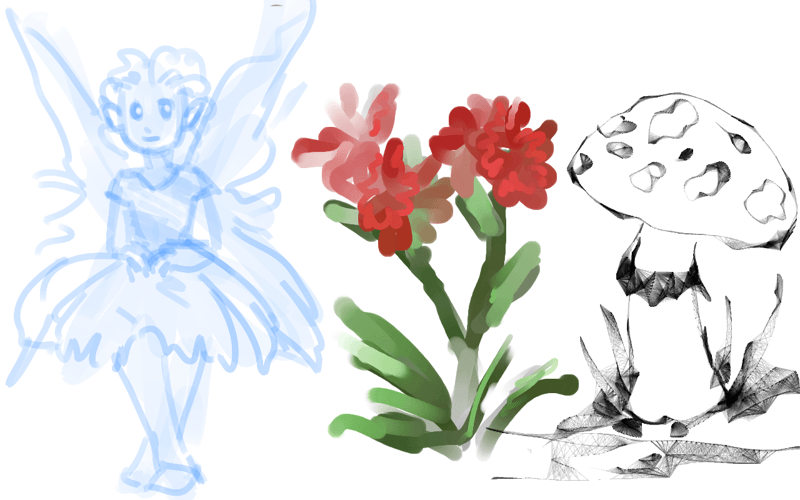
**Gauche :**Brosse de pixels, **Centre :**Brosse de tâches de couleurs, **Droit :**Brosse de croquis.¶
For example, the pixel-brush engine is simple and allows you to do most of your basic work, but if you do a lot of painting, the color smudge brush engine might be more useful. Even though it's slower to use than the Pixel Brush engine, its mixing of colors allows you to work faster when you need to blend and mix colors.
If you want something totally different from that, the sketch brush engine helps with making messy lines, and the shape brush engine allows you to make big flats quickly. There are a lot of cool effects inside Krita's brush engines, so try them all out, and be sure to check the chapters on each.
You can configure these effects via the Brush Settings drop-down, which can be quickly accessed via the F5 key. These configurations can then be saved into presets, which you can quickly access with the F6 key or the Brush Presets docker.
Les brosses dessinent avec des couleurs mais comment l'ordinateur traite les couleurs ?
Couleurs¶
Humans can see a few million colors, which are combinations of electromagnetic waves (light) bouncing off a surface, where the surface absorbs some of it.
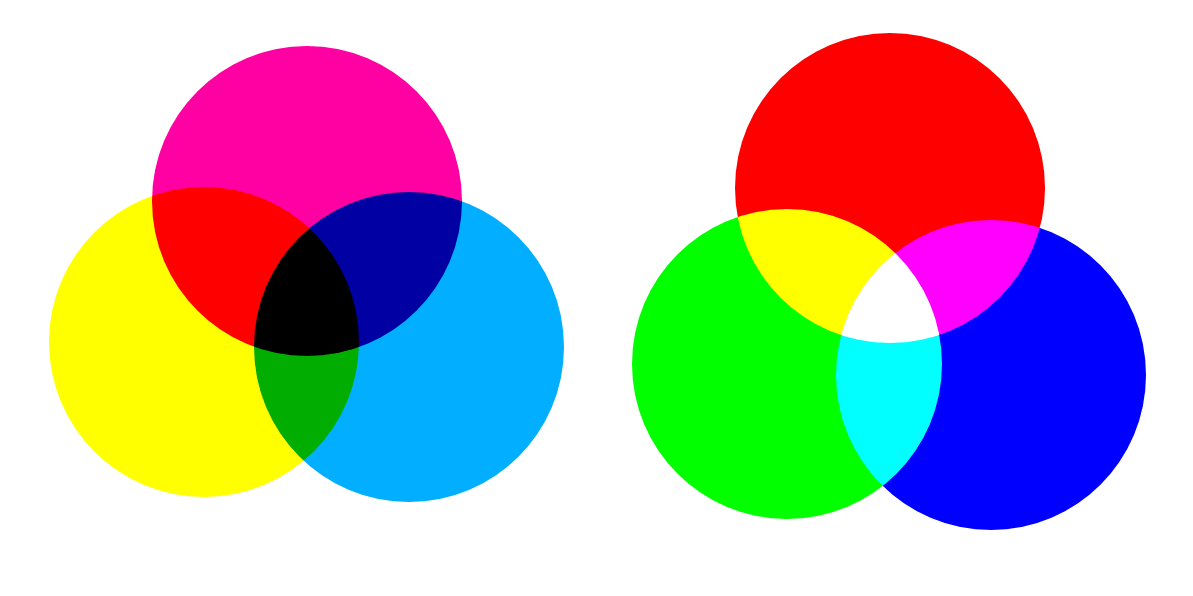
Subtractive CMY colors on the left and additive RGB colors on the right. This difference means that printers benefit from color conversion before printing.¶
Lorsque l'on peint de manière traditionnelle, on utilise des pigments absorbant également les ondes lumineuses correspondant à la couleur souhaitée. Mais, plus on combine de pigments, plus la lumière est absorbée, ce qui donne une sorte de noir obscur. C'est pourquoi nous appelons le mélange des peintures soustractif. Car, plus on combine de pigments, plus la lumière est soustraite. Pour cette raison, dans le mélange traditionnel de pigments, nos couleurs primaires les plus efficaces sont les trois couleurs assez claires : le bleu cyan, le rouge magenta et le jaune (CMJ).
A computer also uses three primaries and uses a specific amount of each primary in a color as the way it stores color. However, a computer is a screen that emits light. So it makes more light, which means it needs to do additive mixing, where adding more and more colored lights result in white. This is why the three most efficient primaries, as used by computers are Red, Green and Blue (RGB).
Per pixel, a computer then stores the value of each of these primaries, with the maximum depending on the bit-depth. These are called the components or channels depending on whom you talk to.
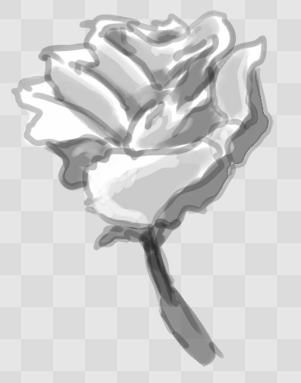
This is the red-channel of an image of a red rose. As you can see, the petals are white here, indicating that those areas contain full red. The leaves are much darker, indicating a lack of red, which is to be expected, as they are green.¶
Though by default computers use RGB, they can also convert to CMYK (the subtractive model), or a perceptual model like LAB. In all cases this is just a different way of indicating how the colors relate to each other, and each time it usually has 3 components. The exception here is grayscale, because the computer only needs to remember how white a color is. This is why grayscale is more efficient memory-wise.
In fact, if you look at each channel separately, they also look like grayscale images, but instead white just means how much Red, Green or Blue there is.
Krita has a very complex color management system, which you can read more about here.
Transparence¶
Just like Red, Green and Blue, the computer can also store how transparent a pixel is. This is important for compositing as mentioned before. After all, there's no point in having multiple layers if you can't have transparency.
Transparency is stored in the same way as colors, meaning that it's also a channel. We usually call this channel the alpha channel or alpha for short. The reason behind this is that the letter 'α' is used to represent it in programming.
Some older programs don't always have transparency by default. Krita is the opposite: it doesn't understand images that don't track transparency, and will always add a transparency channel to images. When a given pixel is completely transparent on all layers, Krita will instead show a checkerboard pattern, like the rose image shown above.
Mode de mélange¶
Because colors are stored as numbers you can do math with them. We call this Blending Modes or Compositing Modes.
Blending modes can be done per layer or per brush stroke, and thus are also part of the compositing of layers.
- Multiplier
A commonly used blending mode is for example which multiplies the components, leading to darker colors. This allows you to simulate the subtractive mixing, and thus makes painting shadows much easier.
- Addition
Another common one is , which adds one layer's components to the other, making it perfect for special glow effects.
- Effacement
is a blending mode in Krita. There is no eraser tool, but you can toggle on the brush quickly with the E key to become an eraser. You can also use it on layers. Unlike the other blending modes, this one only affects the alpha channel, making things more transparent.
- Normal
The blend mode just averages between colors depending on how transparent the topmost color is.
Krita has 76 blending modes, each doing slightly different things. Head over to the Blending Modes to learn more.
Because we can see channels as grayscale images, we can convert grayscale images into channels. Like for example, we can use a grayscale image for the transparency. We call these Masks.
Masques¶
Les maques sont un type de sous-effet appliqués à un calque, généralement piloté par une image en échelle de gris.
The primary types of mask are Masques de transparence, which allow you to use a grayscale image to determine transparency, where black makes everything transparent and white makes the pixel fully opaque.
You can paint on masks with any of the brushes, or convert a normal paint-layer to a mask. The big benefit of masks is that you can make things transparent without removing the underlying pixels. Furthermore, you can use masks to reveal or hide a whole group layer at once!
Par exemple, il y a ici une femme fantôme en blanc :
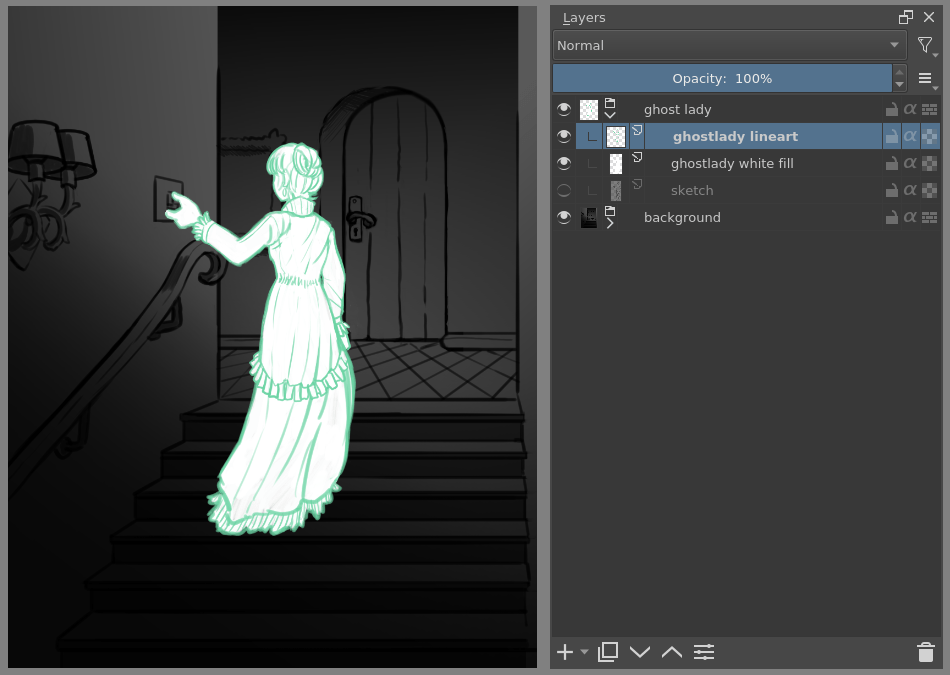
But you can't really tell whether she's a ghost lady or just really really white. If only we could give the idea that she floats. We right-click the layer and add a transparency mask. Then, we select that mask and draw with a black and white linear gradient so that the black is below.
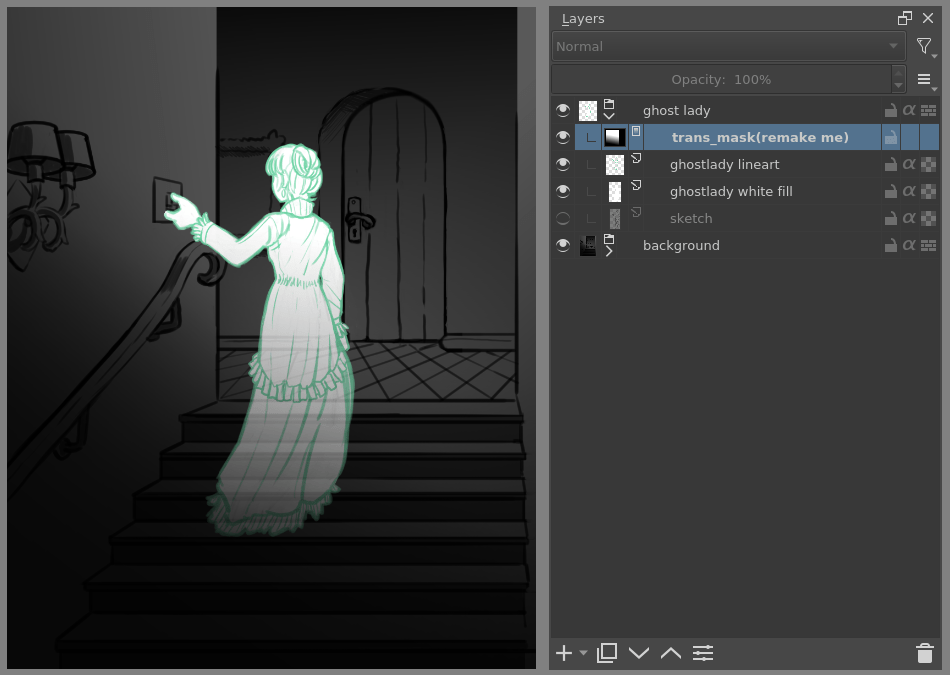
Où que soit le noir, la femme là devient maintenant transparent, la transformant en un véritable fantôme !
The name mask comes from traditional masking fluid and film. You may recall the earlier comparison of selections to traditional masking fluid. Selections too are stored internally as grayscale images, and you can save them as a local selection which is kind of like a mask, or convert them to a transparency mask.
Filtres¶
We mentioned earlier that you can do math with colors. But you can also do math with pixels, or groups of pixels or whole layers. In fact, you can make Krita do all sorts of little operations on layers. We call these operations Filters.
Exemples de ce type d'opérations sont :
- Dé-saturer
Ceci bascule tous les pixels en gris.
- Flou
This averages the pixels with their neighbors, which removes sharp contrasts and makes the whole image look blurry.
- Renforcer
Ceci augmente le contraste entre pixels qui ont un contraste plutôt haut, pour commencer.
- Couleur vers Alpha
Un filtre populaire rendant transparent toutes les couleurs sélectionnées.
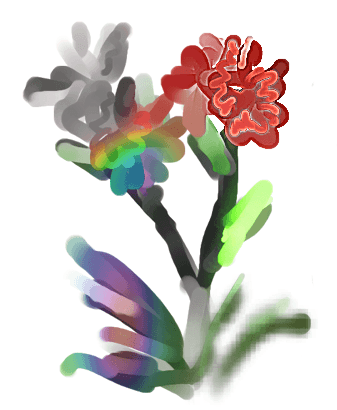
Différentes brosses de filtres en cours d'utilisation sur différentes parties de l'image.¶
Krita possède beaucoup plus de filtres disponibles : vous pouvez lire la document sur eux ici.
Filter Brush Engine¶
Because many of these operations are per pixel, Krita allows you to use the filter as part of the Moteur de filtre de brosses.
In most image manipulation software, these are separate tools, but Krita has it as a brush engine, allowing much more customization than usual.
This means you can make a brush that desaturates pixels, or a brush that changes the hue of the pixels underneath.
Calques de filtres, masques de filtres et styles de masques¶
Krita also allows you to let the Filters be part of the layer stack, via Calque de filtrage and Masques de filtrage. Filter Layers affect all the layers underneath it in the same hierarchy. Transparency and transparency masks on Filter Layers affect where the layer is applied.
Masks, on the other hand, can affect one single layer and are driven by a grayscale image. They will also affect all layers in a group, much like a transparency mask.
We can use these filters to make our ghost lady look even more ethereal, by selecting the ghost lady's layer, and then creating a clone layer. We then right-click and add a filter mask and use Gaussian blur set to 10 or so pixels. The clone layer is then put behind the original layer, and set to the blending mode 'Color Dodge', giving her a definite spooky glow. You can keep on painting on the original layer and everything will get updated automatically!

Layer Effects or Layer Styles are filter masks popularized by Photoshop's that are a little faster than regular masks, but not as versatile. They are available by right-clicking a layer and selecting 'layer style'.
Transformations¶
Transformations are kind of like filters, in that these are operations done on the pixels of an image. We have a regular image and layer wide transformations in the image and layer top menus, so that you may resize, flip and rotate the whole image.
We also have the Outil de rognage, which only affects the canvas size, and the Déplacer which only moves a given layer. However, if you want more control, Krita offers a Transform Tool.
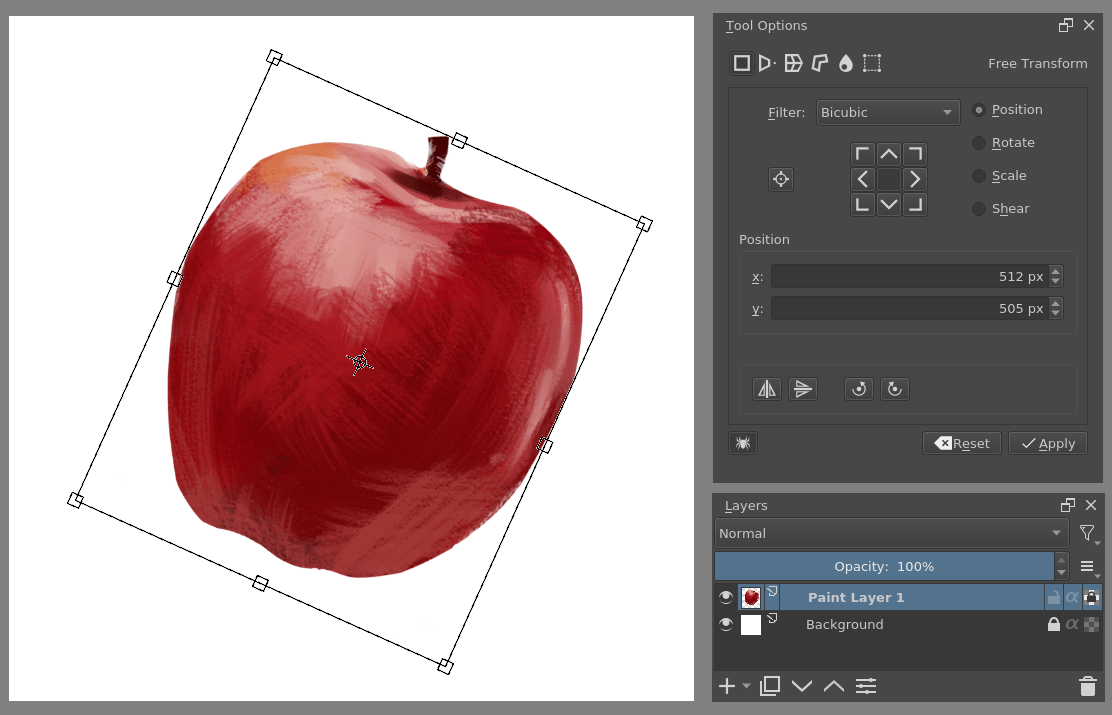
With this tool you can rotate and resize on the canvas, or put it in perspective. Or you can use advanced transform tools, like the warp, cage and liquify, which allow you to transform by drawing custom points or even by pretending it's a transforming brush.
Deform Brush Engine¶
Like the filter brush engine, Krita also has a Deform Brush Engine, which allows you to transform with a brush. This deform is like a much faster version of the Liquefy transform tool mode, but in exchange, its results are of much lower quality.
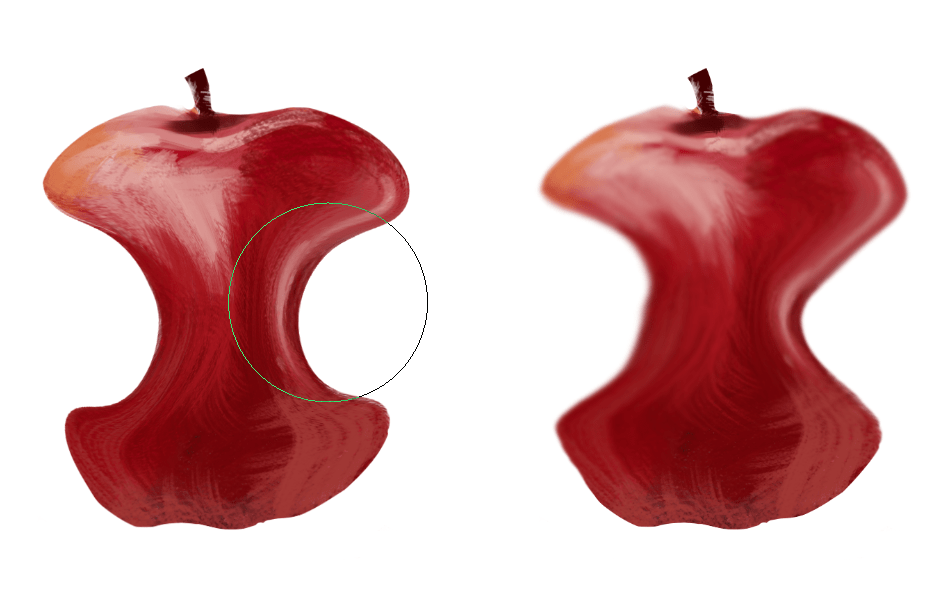
Apple transformed into a pear with liquefy on the left and Deform brush on the right.¶
Par ailleurs, vous ne pouvez pas appliquer la brosse de déformation comme un masque non destructif.
Transform Masks¶
Like filters, transforms can be applied as a non-destructive operation that is part of the layer stack. Unlike filter and transparency masks however, Masques de transformation can't be driven by a grayscale image, for technical reasons. You can use transform masks to deform clone and file layers as well.
Animation¶
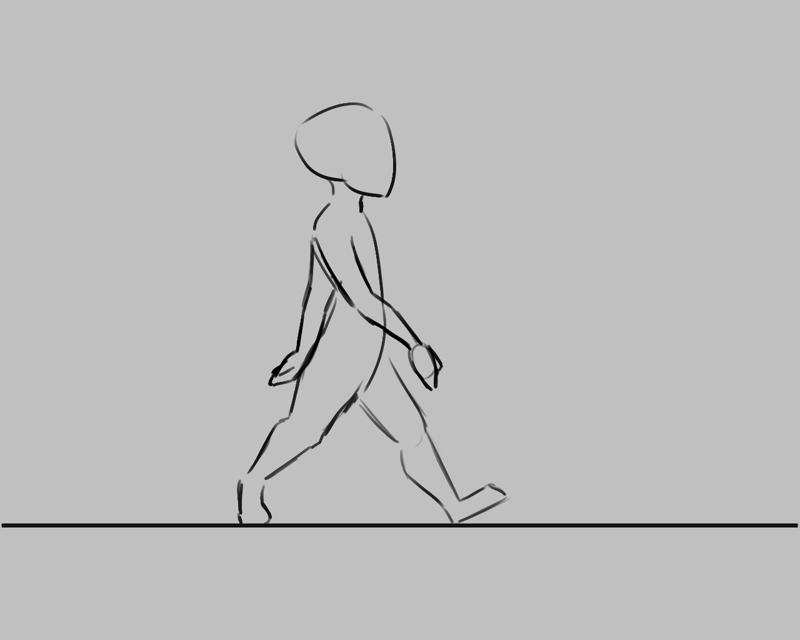
From version 3.0 onwards, Krita got raster animation support. You can use the timeline, animation and onionskin dockers, plus Krita's amazing variety of brushes to do raster based animations, export those, and then turn them into movies or GIFs.
Assistants, grilles et guides¶
With all this technical stuff, you might forget that Krita is a painting program. Like how when working with traditional medium, as an illustrator, you can have all sorts of equipment to make drawing easier, Krita also offers a variety of tools:
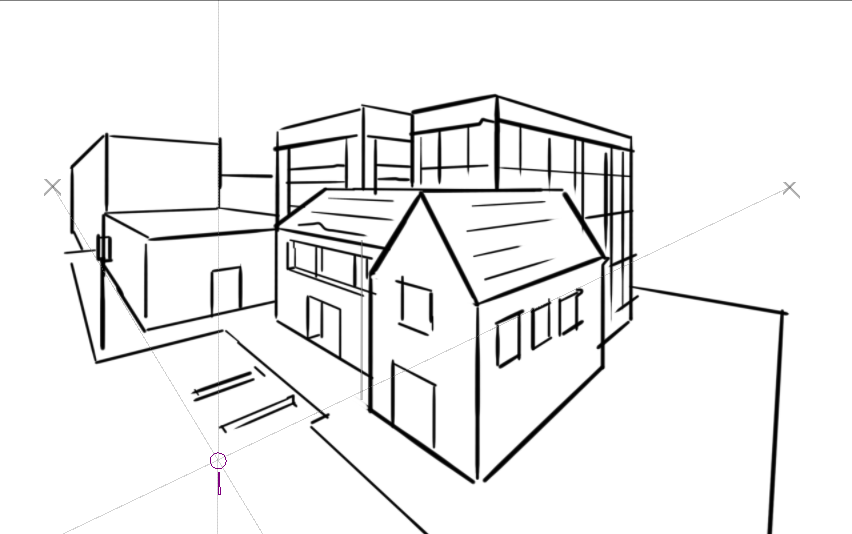
Des assistants de Krita en action pour le point de fuite.¶
- Grids and Guides Docker
Un outil de guidage très direct affichant les grilles ou les lignes de guidage, qui peuvent être paramétrées.
- alignement
You can snap to all sorts of things. Grids, guides, extensions, orthogonals, image centers and bounding boxes.
- Painting with Assistants
Because you can hardly put a ruler against your tablet to help you draw, the assistants are there to help you draw concentric circles, perspectives, parallel lines and other easily forgotten but tricky to draw details. Krita allows you to snap to these via the tool options as well.
Ces guides sont enregistrés dans un format natif de Krita, ce qui signifie que vous pouvez accéder à votre travail rapidement plus tard.
Personnalisation¶
Ceci conduit au concept final : la personnalisation.
In addition to rearranging the dockers according to your preferences, Krita provides and saves your configurations as Espaces de travail. This is the button at the top right.
You can also configure the toolbar via , as well as the shortcuts under both and .
